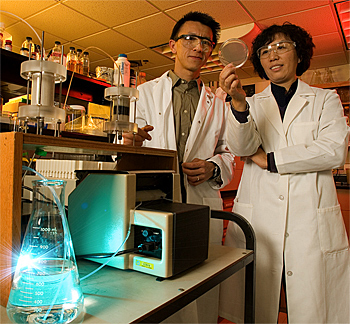
The inexpensive, nonchlorine-based technology developed by UD researchers Yan Jin and Pei Chiu, which could dramatically improve drinking water in a world where over a billion people lack access to safe water supplies, is one of seven innovations showcased in “2007: The Year in Technology,” in NASA's Tech Briefs [www.techbriefs.com]. The publication is the largest-circulation engineering magazine in the nation, with more than 190,000 subscribers.
Linda Bell, editorial director of NASA's Tech Briefs, made the top picks after consulting dozens of resources reporting on cutting-edge technologies in industry, government, and academia.
“I went through those that I had come across during the year that were the most innovative and had the greatest potential to result in both commercial and public benefit,” Bell said. “I'd say I reviewed literally hundreds of technologies that were all interesting in their design and application, but ultimately chose the seven that appear in the article as the most exciting, most promising technologies that ultimately could help a wide range of people.”
Reported in February on the University's UDaily news service [www.udel.edu/PR/UDaily/2007/feb/viruses022607.html], the technology developed by Jin, a professor of environmental soil physics in the College of Agriculture and Natural Resources, and Chiu, an associate professor of civil and environmental engineering in the College of Engineering, incorporates highly reactive iron in the water-filtering process to deliver a chemical “knock-out punch” to a host of pathogens, from E. coli to rotavirus. The technology can remove harmful microorganisms from drinking water, including 99.999 percent of viruses.
Viruses are difficult to eliminate in drinking water using current methods because they are far smaller than bacteria, highly mobile, and resistant to chlorination, which is the dominant disinfection method used in the United States.
Besides safeguarding drinking water, the technology also may have a number of applications in agriculture, which are being actively explored by Jin and Chiu in collaboration with UD virologist Kali Kniel.
Integrated into the washwater system at a produce-packing house, the iron-based filtration system could help clean and safeguard fresh vegetables, particularly leafy greens like lettuce and spinach, as well as fruit.
The Centre for Affordable Water and Sanitation Technology in Calgary, Canada, currently is exploring use of the technology in a portable water treatment unit, according to Richard Holsten, associate provost for research at UD.
In addition to UD's novel technology, the article highlights wireless power transfer by scientists at the Massachusetts Institute of Technology, Boston University's discovery of free radical production as a pathway for “superbug” infections, paper batteries made by Rensselaer Polytechnic Institute, the University of California at Berkeley's use of electric pulses to destroy cancer cells, self-healing materials that mimic human skin created by University of Illinois scientists, and a new device made by Sandia National Laboratories for screening toxic materials.
The University of Illinois technology also has a UD connection. Nancy Sottos, one of the researchers who developed the self-healing materials, received her doctorate in mechanical engineering from UD in 1990.
Article by Tracey Bryant
Photo by Kathy Atkinson

